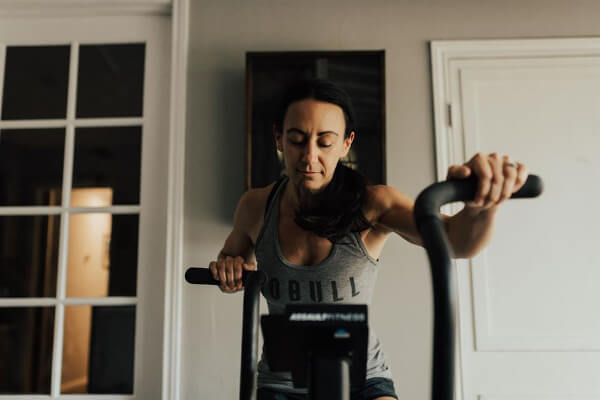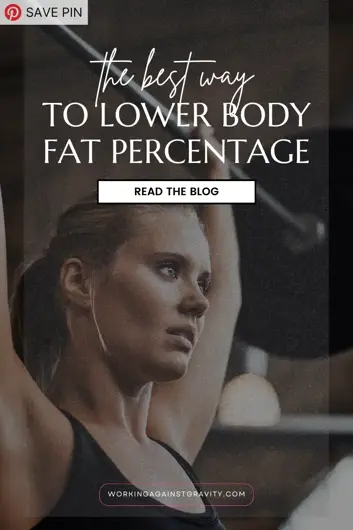
Across the board, one of our clients' most common goals is learning the best way to lower body fat percentage.
When we hear our clients ask, "What is the best way to lower body fat percentage?" we know that their goal is improving body composition. This typically means lowering body fat while increasing lean muscle mass.
It's important to remember that losing fat doesn't mean getting rid of body fat completely. You need to have some body fat to maintain your health.
Losing body fat may help you achieve the slimmer, toned look that you're after. If you're at an unhealthy body fat percentage, dropping some weight can also help increase your energy, performance, and confidence.

Advertisement
How Does Body Fat Affect Your Health?
Before we discuss the best way to lower body fat percentage, let's examine how body fat affects health and what a healthy body fat percentage looks like.
The Main Types of Body Fat
There are three main types of body fat:
- Essential fat
- Subcutaneous fat
- Visceral fat
What is Essential Fat?
Essential fat is the amount of body fat necessary for survival. This type of fat provides insulation to help keep you warm, protects and cushions your organs, and allows you to absorb certain vitamins.
What is Subcutaneous Fat?
Subcutaneous fat is the fat that lies directly underneath your skin's surface. When you talk about fat, this is the type you're probably thinking about.
Advertisement
What is Visceral Fat?
Visceral fat is a deep type of fat that surrounds your organs. You can't see visceral fat, but it's the most dangerous type of body fat because it's biologically active, which means it can produce hormones and other substances that affect your health. Visceral fat is connected to insulin resistance and metabolic diseases, and it can shorten your lifespan [1].
While subcutaneous fat may motivate you to lose some body fat, visceral fat is most concerning. The good news is when you lower your body fat percentage, you lose some of both types.
Keep in mind that while too much body fat is more of a widespread concern, having a really low body fat percentage comes with its own set of health problems, like:
- Increased risk of vitamin deficiencies, especially the fat-soluble vitamins A, D, E and K
- Decreased muscle mass
- Heart problems
- Brain and nervous system disorders
What is the Ideal Body Fat Percentage?
Now that you know the health risks associated with having too much or too little body fat, the next question is, “What's a healthy body fat percentage?” You might even wonder, “What is my ideal body fat percentage?"
Advertisement
Healthy body fat percentages are given in ranges and differ between men and women. Let's break them down:
Healthy Body Fat Percentages for Women
A healthy body fat percentage for women is between 25-31%. Anything over 32% body fat for women is classified as obesity [2]. Physically fit women with higher muscle mass typically have body fat percentages between 21 and 24%.
Healthy Body Fat Percentages for Men
A healthy body fat percentage for men is between 18 and 24%. Anything over 25% is considered obese [2]. Like women, men who exercise more and carry more muscle will typically sit at a lower body fat range. For them, this range is around 14-17%.
Curious about what kinds of nutrition and lifestyle habits are required to reach your desired level of leanness? Check out this article!
Advertisement
How Long Does it Take to Lose 5% Body Fat?
If you're in a sufficient calorie deficit, you can generally expect to lose 1-3% body fat monthly. This means that it could take up to five months to lose 5% body fat and ten months to lose 10% of your body fat.
But so many factors come into play, like lifestyle, consistency with your diet, starting weight and body composition, and so much more. Working with a nutrition coach who will get to know you, your goals, and your body is the best way to set realistic goals and expectations for losing body fat.
When Is It Safe To Lose Weight?
There are times when your body is primed and ready for weight loss. Here are a few situations when it is safe to lose weight:
- If you are at or above the obesity percentages we shared above
- If you have been eating at calorie maintenance or surplus for a prolonged period (wondering what this means for you? A 1:1 online nutrition coach can give you specifics based on your body and goals!)
- If you're in the "healthy body fat percentage" range and want to lean out a bit more (this is even easier if you're new to strength training!)
- For women: because calorie deficits and weight loss can impact your hormone levels more than we typically see in men, it is safe to lose weight when you are regularly cycling and have an all-clear from your OBGYN!
When Is It Unsafe To Lose Weight?
It is possible to lose too much weight.
Remember, essential body fat is the minimum amount of body fat you need to stay healthy. This is around 10-13% for women, and for men, it's considerably lower at 2-5%. We recommend avoiding these percentages [2].
Advertisement
Some times it may be unsafe to lose weight are:
- If you are below the "healthy" or "physically fit" levels we shared above
- If you have been eating at a calorie deficit for a long period and are not seeing any changes in weight or body composition
- If you are losing weight at a very quick rate and are noticing major changes in your energy, mood, performance, sleep, and stress
- For women, losing weight during pregnancy is not recommended in most situations. It may also be a sign it is unsafe to lose weight if you've been dieting and lost your cycle.
Body Fat Percentage vs. Body Mass Index
“BMI” (or body mass index) is a concept that has been around for a while. Many people wonder if BMI is the same as body fat percentage. Before discussing how to measure body fat, we need to quickly discuss the difference between body fat percentage and body mass index, or BMI.
Your body fat percentage measures how much of your body weight exists in the form of fat.
Your body mass index is a way to determine whether you're at a healthy weight for your height. While some people say that you can determine whether or not you have too much body fat by calculating your BMI, it's not really an accurate measure of body fatness or even overall weight status.
Because BMI only uses your height and body weight, it can't effectively measure body composition. This is especially apparent for people with a lot of muscle mass, like bodybuilders.
Advertisement
Bodybuilders may weigh more than other people of the same height because they have more muscle and lean body mass, which is denser and can lead to higher numbers on the scale.
If you want an accurate picture of your percent body fat, you have to measure it directly.
How to Measure Body Fat
The quickest way to measure body fat at home or at your gym is with skinfold calipers. Calipers measure the thickness of your skin, including the underlying fat mass, to give you an idea of how much body fat you have.
There are other ways to measure body fat too, but you can't do them at home. You must find a fitness or medical center near you that provides these services.
Advertisement
Some other ways to measure body fat are:
- DEXA scan
- Hydrostatic weighing
- Bioelectrical Impedance Analysis (BIA)
- Bioimpedance Spectroscopy (BIS)
- Air Displacement Plethysmography (Bod Pod)
- Electrical Impedance Myography (EIM)
- 3D Body Scanners
Remember that while these methods sound really fancy, they're not superior to regular old skinfold calipers. To put it into perspective, skinfold calipers have an error rate of 3.5% to 5% [3], while DEXA scans have an error rate of about 4% [4]
That's why you should consider any body fat measurement as a way to observe trends in your body composition and measure overall progress instead of getting hung up on the exact number.
How to Lower Body Fat Percentage Quickly
Wondering how quickly you can lower your body fat percentage? If you've had your body fat percentage tested and it's higher than you'd like, or you've just not felt like yourself lately and want to do something about it, the next step is figuring out how to lower it.
Advertisement
It is important to remember that this is just one piece of information. You can use it to assess whether or not the efforts you put into fat loss are working or if something needs to change or adjust. But it isn’t the only measure of progress.
Just like the number on a scale is part of a bigger picture, your current body fat percentage is also just a number.
Connecting back to factors like how you feel in the gym, increases in energy, food quality, changes in measurements, and how your clothes fit are all other measures of progress to keep an eye on through your journey.
1. Try High-Intensity Interval Training for Fat Loss
High-intensity interval training, or HIIT, involves alternating short bursts of high-intensity exercise with slightly longer periods of low-intensity exercise.
The goal is to spend 20 to 90 seconds working as hard as possible to increase your heart rate and then back off a little to quickly recover before you rinse and repeat.
Advertisement
Research shows that HIIT can increase your metabolic rate and reduce both subcutaneous fat and belly fat better than other types of exercise, including moderate-intensity training and aerobic exercise [5, 6].
For optimal fat burning, try HIIT workouts a few times per week. If you're new to the concept of HIIT, a personal trainer can show you the way.
2. Resistance Train for Fat Loss
Along with high-intensity interval training, you'll also want to regularly incorporate resistance training, also known as strength or weight training.
Resistance training can help improve your body composition by helping you build muscle and lose fat at the same time.
In one study, a group of overweight women was instructed to start resistance training with resistance bands three times per week. After a 12-week period, the women lost a significant amount of overall body fat and belly fat without any muscle loss [7].
Advertisement
When compared to other types of exercise, resistance training also has a higher excess post-exercise oxygen consumption, or EPOC, for short. This means that your metabolism may stay higher for longer after weightlifting, so you can burn more calories even after your workout is over [8].
Gaining muscle can increase your resting metabolic rate, or RMR, which means you burn more calories, even when you're not doing anything.
3. Eat at a Calorie Deficit (and Hit Your Macros Consistently)
You may have heard “you can’t outrun your fork” or that fitness is 20% exercise and 80% nutrition. Those percentages aren’t exact — they’re just part of the saying — but the point is that lowering body fat percentage requires a balance between exercise and food.
While regularly hitting the gym is essential to improving your body composition, spending an hour or two working out every day won’t offset constant snacking and eating meals. Think about it, you spend 1-2/24 hours in the gym. The rest of that time, you’re either sleeping or in an environment with tons of treats and temptations that are easy to grab.
If you want to accelerate fat loss, it’s important to consistently hit your macros—or carbohydrates, protein, and fat recommendations.
Advertisement
Macros are based on your caloric needs, so when you prioritize hitting them, you naturally stay on the right calorie diet for you. This will prevent you from taking in extra calories that can make it harder to burn fat.
4. Focus on Micronutrient-Rich Foods
One of the really great things about flexible dieting is that it’s, well, flexible. There’s a lot of room for you to eat all of your favorite foods while still staying within your macros.
But if you’ve noticed a stall in your progress or you really want to dial it in, try to focus on including as many micronutrient-rich foods into your meal plan as possible.
In other words, choose foods with high amounts of vitamins, minerals, and antioxidants over foods that don’t have as much to offer in that department.
This will naturally lead you to choices like fruits, fiber-rich vegetables, lean proteins, and slow-digesting carbs that keep you full and balance your blood sugar while also helping you slim down.
Advertisement
5. Manage Your Stress Levels
It's not all about dieting and exercise, though. Your body composition also has much to do with your mental health and how you handle stress.
When you're stressed out all the time, it increases the amount of cortisol in your blood. High cortisol levels can make you store more body fat, especially in the form of belly fat [14].
While it's impossible to get rid of stress completely, you can become more resilient to the effects of stress by regularly practicing things like yoga, meditation, and deep breathing.
Learning how to say "no" and maintaining a good work-life balance is also critical to healthy stress levels.
6. Get Enough Sleep
Sleep plays an imperative role in weight maintenance. Several studies have linked getting less than seven hours of sleep per night with a higher body fat percentage [15].
Advertisement
When you don’t get enough sleep, the resulting low energy causes you to move less throughout the day. This makes it much more tempting to skip your workout, and your NEAT (non-exercise activity thermogenesis) naturally decreases as well. This decreases overall calorie burn throughout your day.
Lack of sleep also triggers a spike in your stress hormone, cortisol. This triggers your body to conserve energy (aka, body fat). Your hunger and fullness hormones are also impacted. Your “I’m hungry” hormone, ghrelin, increases, and your “I’m full” hormone, leptin, decreases. This is a double-whammy when it comes to hunger. When you’re hungry, tired, and stressed, this is a recipe for overeating and putting on weight [16]. What can you do about it? Here are a few quick tips to help you increase your sleep quality:
- Stick to a regular sleep schedule
- Turn off electronics at least 30 minutes (preferably more!) before bed
- Keep your room cool, dark, and quiet
- Get more sunshine
- Exercise regularly
For more tips on improving sleep, check out our articles 15 Simple Strategies for a Good Night’s Sleep and Creating a Bedtime Routine.
Let Working Against Gravity Help You
The truth is, regardless of what you're doing, you should only expect to lose about 0.5-1% of your body fat, at most, each week. That's why consistency and patience are key.
We know that you’re eager to reach your goals, but long-term results require long-term commitments, and that’s why we’re here.
Advertisement
WAG Nutrition Coaching can help guide you through the process of reducing body fat in a way that works for you. You get accountability, unlimited support, and access to a like-minded community that will encourage you to work toward your body composition goals.
Schedule a Free Intro Call
Working Against Gravity has led the macro tracking and health space for over a decade. Our team doesn’t just understand the science of nutrition—we’ve spent years mastering the art of tailoring it to fit your life. That means no cookie-cutter plans, just real strategies that have worked for over 30,000 people.
Schedule a free call with our team to learn how working with a 1-on-1 WAG coach will help you reach your goals.



